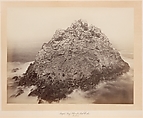Sugar Loaf Islands, Farallons
Carleton E. Watkins American
Not on view
Watkins's technical virtuosity was honed in Yosemite, first in 1861 and again in 1865-66, when he returned as the official photographer for Josiah Whitney's California State Geological Survey. By the end of his extended stay he had mastered the manipulation of the cumbersome camera (three feet long when extended) and the mammoth glass plates, which had to be sensitized and developed in a dark room tent, often with water hauled by mules over long distances. Upon returning to San Francisco, Watkins printed his large negatives by laying them directly on albumen printing-out paper in the sun. His uncommon talent was recognized locally by Whitney, Clarence King, and others of the scientific community, nationally by the photographic press, and internationally through an award-winning display at the Exposition Universelle in Paris in 1867.
In 1868-69, Watkins visited the Farallon Islands thirty miles west of San Francisco, rocky outcrops inhabited by seals and sea birds. Although the islands were visited regularly by fishermen and commercial collectors of bird eggs, in this photograph Watkins avoided any reference to man. Isolated from the neighboring islands, the triangular rock is depicted as if on the fifth day of Creation when, the dry land having emerged from the swirling sea, the waters brought forth swarms of living creatures.
Due to rights restrictions, this image cannot be enlarged, viewed at full screen, or downloaded.


